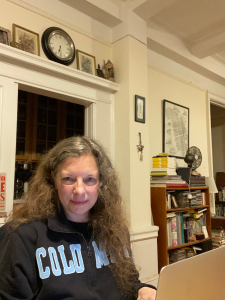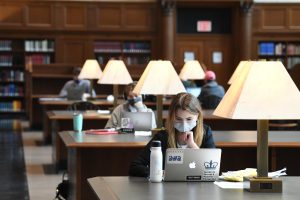Q: What is your role in the Libraries, and what is your “office space” like these days since you’re not physically on campus?
I’m the Head of Web Services for the Libraries. I’m responsible for managing what we call the Libraries web presence, which means the sites that provide library services and resources. Those sites range from the main Libraries website to our blogs and beyond. I get to work with a great team of front-end designers/developers and back-end

programmers, as well as with people from almost all of the different departments in the Libraries to create our Libraries web presence. Part of my role is to assess the sites and ensure that our user experience meets the needs and expectations of the Columbia community as well as other researchers throughout the world.
I am a librarian, so I also get to teach research sessions and staff the Ask a Librarian chat reference service. I am really lucky because I get to collaborate with lots of people in the libraries and across the University, and I also get to plan and conduct user studies to assess how well our online resources work. That helps me find ways to improve our online services and to make them user-centered, intuitive, and friendlier.
These days my “office space” is my dining room table in the main living space in my apartment. It’s where I now spend many of my waking hours! I have a few things that I brought home with me when we closed in March (files, my planner, and few of my notebooks from the office) as well as all the office plants I could cart home. Since I now work mainly from my

laptop, I’ve been able to adapt the end of my table pretty effectively, though some days my piles of paper and tech gear feel like they might take over!
Typically my two dogs nap and snore disruptively during Zoom meetings … unless they want attention and then they come under the table and either put their heads in my lap or nose my arms until I pet them or give them a treat.
Q: Following the determination this past summer that the Libraries would reopen with limited study space, what was the process like to create a seat reservation system that would be ready for the start of the semester?
It was very rapid! I drank a lot of coffee!
We had to quickly identify a service provider, work with the Libraries administrators and recovery planning team to identify what functionality and services were required, and ensure that our reservation system would support and align with campus expectations around safety protocols, density requirements, and our community’s needs. We worked quickly to identify hours, the number of seats that were safe in the spaces that would reopen, how to set spaces up so that the reservation system and the physical location configurations aligned, and how we could ensure that the process both allowed our community to make reservations as easily as possible while also alerting those reserving seats about the necessary COVID safety measures. Making sure the system supported uni authentication, would allow us to make it look and feel like a Libraries site, and provided what we needed on the back end was complicated because of the compressed timeframe, the number of rooms, and the different needs in the different locations.

It was like a puzzle that needed to be solved very quickly, but we didn’t know the shape of the outline nor did we have a lot of the edge pieces until we were almost ready to reopen. Some days it felt like all of the pieces were moving around and changing shape! We essentially tested it live when we reopened the week before classes, and we corrected glitches as quickly as possible. We continue to work with the vendor on some ongoing issues, but all that work definitely paid off.
Q: How does the seat reservation work for users?
Users go to our Seats site, seats.library.columbia.edu, and select the library and room where they want to work. Once they specify the room or area they want to sit in, a list of the seats appears. Available seats and times are green. Seats that are already reserved are red. Once they select the seat and a block of time, they log in, acknowledge that they have agreed to the Columbia compact, and then complete the reservation. A confirmation email with instructions about how to “check in” to their seat with a URL or QR code (both provided in the email) is sent. Before they head to the location, they complete the attestation app that will give them access to campus buildings. Then they can go to the library room where their seat is and use the printed QR code at the seat to check in.
Q: Working from home has been challenging for some Columbians, but remote work in tech might have some benefits. What are some ways you’re staying connected and motivated?
My team connects on Google Chat a lot throughout the day, often with work questions or conversations but also with non-work related stuff like jokes and memes and check-ins to connect with each other. I have team

meetings that help me stay connected ,and hearing about what others are doing motivates me and sparks the team’s creativity and problem-solving. Walking my two dogs and doing yoga help motivate me and make my workday feel more routine. As I have time to focus on pre-pandemic library projects, they help me stay energized and positive. I’m involved in a lot of meetings throughout the day, and when I get Zoomed out, I listen to music and concentrate on completing specific project work or mapping out upcoming tasks so that I accomplish something that feels more concrete than meetings sometimes do!
Q: You recently earned a Master’s degree in Creative Writing from Columbia’s School of the Arts. Congratulations! What intersections have you found (or would you like to explore) between technology/web work and creative writing?
More than one might at first think. The technology and web work that I do is often super creative and always involves trying to communicate with users, just like my writing is an attempt to communicate with readers. Audience is an important factor in both, and it has to be considered at the right point in the process for both to ensure that ideas are free-flowing when they need to be but can then be constrained, if needed, and clarified so that they are understandable. I’d love to more concretely explore the connections/intersections between the planning processes and research processes for both types of work. I know I tend to storyboard ideas similarly for both, and I think a lot about how content and language works in various contexts and structures — from web pages to poems to essays.
Figuring out the ways that our web presence can most effectively engage with and communicate to our users aligns with how I approach my writing.